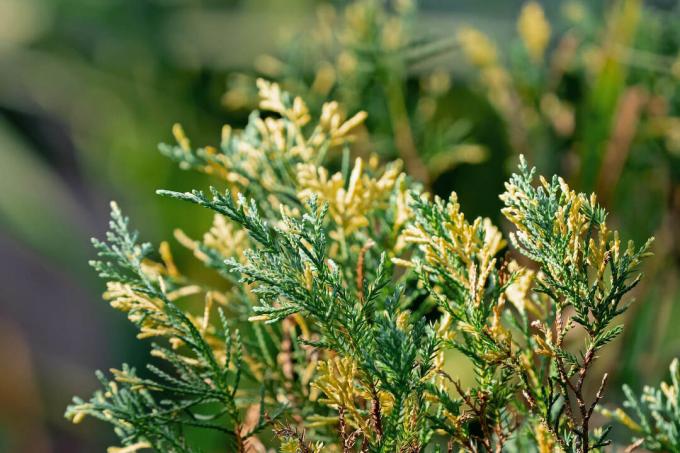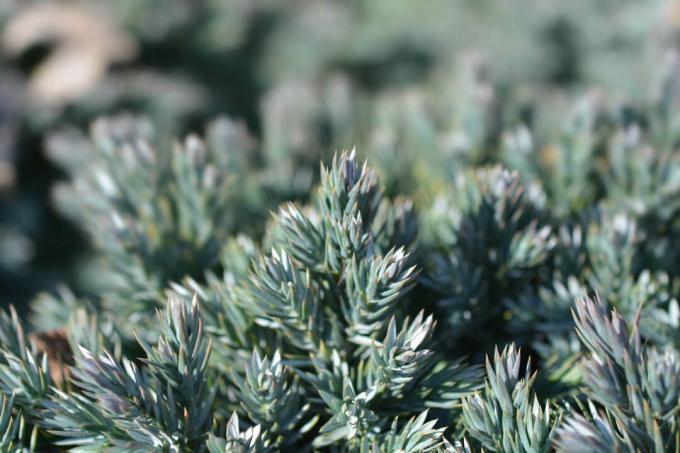The juniper genus is very versatile and includes a wide variety of species in different shapes and colors. We present the most beautiful ones for the garden.

Whether ground cover or columnar juniper, many species can be planted in the garden as ornamental trees. Most of them have different types of juniper, so there is something for every taste. We have put together a small selection as an overview for you.
contents
- Types of juniper: how many are there and where are they found?
-
The most beautiful juniper species for the garden
- Juniperus chinensis
- Juniperus horizontalis
- Juniperus scopulorum
- Juniperus sabina
- Juniperus squamata
- Juniperus virginiana
Types of juniper: how many are there and where are they found?
The genus of plants juniper (Juniperus) comprises about 70 different species, almost all of which are found in the northern hemisphere. Only the East African juniper (Juniperus procera) also grows in the southern hemisphere. The species are in turn divided into three subgenera or sections. Some juniper species occur naturally in our latitudes, but others can also be planted in the garden. We present the most beautiful ones and also recommend some juniper varieties.

The most beautiful juniper species for the garden
Not all of the 70 juniper species are also suitable for the garden. However, many are used as ornamental trees. They differ mainly in growth habit, needle shape and color.
Juniperus chinensis
Chinese juniper occurs naturally in East Asia and is also found as an ornamental plant in gardens. It is versatile, can be kept in beds and in tubs and can be cut into shape. The leaves of this species are either scale-like or needle-like. Both leaf shapes can also be found on a plant. Together with the common juniper (Juniperus communis) the Chinese juniper is the most commonly used juniper species in the garden. There are also different varieties of this species.

- Juniperus chinensis 'Obelisk': This variety has dark green needles and grows columnar, which is why it is also called cone juniper. The growth height in old age is about 4 m.
- Juniperus chinensis 'Blauw': The juniper variety 'Blaauw' has a grey-blue needle coloration and grows up to 2.5 m high. It grows like a funnel and looks like a fountain.
- Juniperus chinensis 'Variegata': As the name suggests, this variety has multicolored foliage with partly green and partly yellow needles. In addition, it grows to about 4.5 m in height.
Tip: Caring for a juniper as a bonsai is possible with many species. But they are best suited for this Juniperus communis and Juniperus chinensis.
Juniperus horizontalis
This species is also known as creeping juniper or carpet juniper. Its names refer to its growth habit, because it grows flat and covers the ground. It is native to North America, but can also be planted here. Like the Chinese juniper, this species has two types of leaves, which can be scale-like or needle-like.

- Juniperus horizontalis 'Glauca': This variety attracts attention with its blue-green needles and grows ground-covering, reaching a maximum height of 15 cm but a spread of up to 2 m.
- Juniperus horizontalis 'Blue Chip': Equally creeping but with steel blue needles grows this blue creeping juniper. The variety is also faster-growing than 'Glauca'. 'Blue Chip' grows to about 40 cm high and 2 m wide.
Juniperus scopulorum
The cypress juniper or Rocky Mountain juniper comes from western North America. Due to its upright and narrow habit, it is also known as columnar juniper. It usually grows with a single trunk and is therefore particularly suitable as a solitary tree. Both needle and scaly leaves are also found here.
- Juniperus scopulorum 'Blue Arrow': This variety has blue-green needles and can reach heights of up to 6 meters. It is also called blue rocket juniper 'Blue Arrow'.
- Juniperus scopulorum 'skyrocket': The rocket juniper 'Skyrocket' with green needles grows a little higher at 8 meters.

Juniperus sabina
The Sade tree has many names, including stink juniper, sevi tree or poison juniper. In addition to the common juniper, the sallow tree is the only species of the genus that is also native to Central Europe.
Distinguish between sade tree and common juniper:
| Sadebaum | Common juniper | |
|---|---|---|
| toxicity | Poisonous | non-toxic |
| foliage shape | Female plants: scale-like, close fitting Male plants: pungent |
Three in whorls, piercing, with white stoma band on fluted top. |
| foliage size | Individual leaflets under 1 cm | Individual leaves 1 - 2 cm |
| odor | Crushed leaves (of the female plants) smell unpleasant | Crushed leaves smell pleasant |
tip: The pear rust, which is dangerous for pears, uses the Sade tree as its main host. So if you have both plants in the garden, you should be alert and look out for the orange fruit bodies.

- Juniperus sabina 'Variegata': This form of the Sade tree develops green as well as white-yellowish leaves and is therefore bicolored. Growth height: 2 m.
- Juniperus sabina 'Rockery Gem': The variety is also called blue-green moss juniper and grows flat in width. Growth height: 50 cm.
Attention: All parts of the Sade tree are poisonous. Unfortunately, the berries of the two species can hardly be distinguished!
Juniperus squamata
This species is also called scaly juniper, although it only develops needle-shaped leaves. Its range extends across East and Central Asia. In nature it reaches heights of up to twelve meters, but is also available in dwarf form as an ornamental tree.
- Juniperus squamata 'Blue Star': The dwarf juniper 'Blue Star' grows very stocky and compact. The needle color is silver-blue, it is also called blue cedar juniper. Growth height: 1 m.
- Juniperus squamata 'Blue Carpet': This creeping juniper is also called blue carpet juniper or blue creeping juniper. It grows ground covering and stands out with its steel blue needles. Growth height: 50 cm.

Juniperus virginiana
The Virginian juniper is also called Virginian red cedar because its foliage turns slightly reddish in autumn. The scaly and needle-shaped leaves of the cone-shaped tree are pleasantly fragrant. However, all plant parts of this North American species are poisonous. It is the largest of all juniper species and can reach heights of around ten meters.
- Juniperus virginiana 'Grey Owl': This variety grows in width rather than height and has gray-blue, scale-like needles. It grows about 3 m high.
- Juniperus virginiana ‘Canaertii’: Due to the scaly leaves, this green juniper is also called dark green cypress juniper and reaches an impressive height of 8 m.

Once you've decided on a species, it's now a matter of knowing how to Planting and caring for juniper. We give some useful tips.



